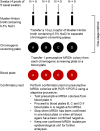Technical specifications for a baseline survey on the prevalence of methicillin-resistant Staphylococcus aureus (MRSA) in pigs
- PMID: 36267542
- PMCID: PMC9579990
- DOI: 10.2903/j.efsa.2022.7620
Technical specifications for a baseline survey on the prevalence of methicillin-resistant Staphylococcus aureus (MRSA) in pigs
Abstract
The European Commission requested scientific and technical assistance in the preparation of a EU-wide baseline survey protocol for a European Union (EU) coordinated monitoring programme on the prevalence of methicillin-resistant Staphylococcus Aureus (MRSA) in pigs. The objective of the survey is to estimate the MRSA prevalence in batches of fattening pigs at slaughter at both European and national levels, with a 95% level of confidence and a level of precision of 10% considering an expected prevalence of 50%. The survey protocol defines the target population, the sample size for the survey, sample collection requirements, the analytical methods (for isolation, identification, phenotypic susceptibility testing and further genotypic testing of MRSA isolates), the data reporting requirements and the plan of analysis. The samples are to be analysed according to the laboratory protocols available on the European Union Reference Laboratory (EURL-AR) website. Generalised linear models will be used to estimate proportion (with 95% confidence intervals) of batches of slaughter pigs tested positive to MRSA. The necessary data to be reported by the EU Member States to support this baseline survey are presented in three data models. The results of the survey should be reported using the EFSA data collection framework.
Keywords: antimicrobial resistance; cross‐sectional prevalence study; fattening pigs; harmonisation; methicillin‐resistant Staphylococcus aureus.
© 2022 Wiley‐VCH Verlag GmbH & Co. KgaA on behalf of the European Food Safety Authority.
Figures



AST: antimicrobial susceptibility testing; MRSA: methicillin‐resistant Staphylococcus aureus; WGS: whole genome sequencing.
References
-
- Agersø Y, Vigre H, Cavaco L and Josefsen M, 2013. Comparison of air samples, nasal swabs, ear‐skin swabs and environmental dust samples for detection of methicillin‐resistant Staphylococcus aureus (MRSA) in pig herds. Epidemiology and infection, 142, 1–10. 10.1017/S095026881300280X - DOI - PMC - PubMed
-
- Bangerter PD, Sidler X, Perreten V and Overesch G, 2016. Longitudinal study on the colonisation and transmission of methicillin‐resistant Staphylococcus aureus in pig farms. Veterinary Microbiology, 183, 125–134. - PubMed
-
- Battisti A, Franco A, Merialdi G, Hasman H, Iurescia M, Lorenzetti R, Feltrin F, Zini M and Aarestrup FM, 2010. Heterogeneity among methicillin‐resistant Staphylococcus aureus from Italian pig finishing holdings. Veterinary Microbiology, 142, 361–366. - PubMed
-
- Bortolaia V, Kaas RS, Ruppe E, Roberts MC, Schwarz S, Cattoir V, Philippon A, Allesoe RL, Rebelo AR, Ferrer Florensa A, Fagelhauer L, Chakraborty T, Neumann B, Werner G, Bender JK, Stingl K, Nguyen M, Coppens J, Britto Xavier B, Malhotra‐Kumar S, Westh H, Pinholt M, Anjum MF, Duggett NA, Kempf I, Nykäsenoja S, Olkkola S, Wieczorek K, Amaro A, Clemente L, Mossong J, Losch S, Ragimbeau C, Lund O and Aarestrup FM, 2020. ResFinder 4.0 for predictions of phenotypes from genotypes. Journal of Antimicrobial Chemotherapy, 75, 3491–3500. 10.1093/jac/dkaa345 - DOI - PMC - PubMed
LinkOut - more resources
Full Text Sources
Research Materials
